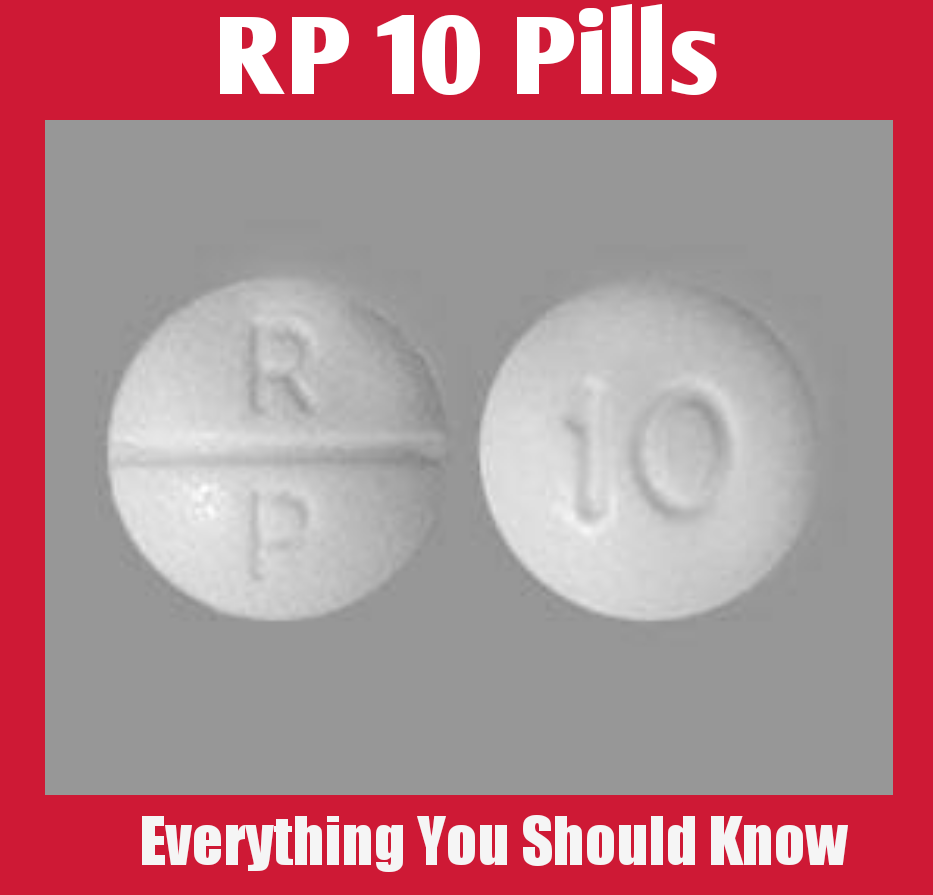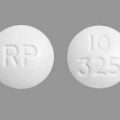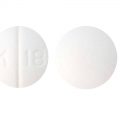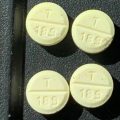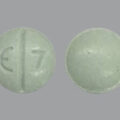The white round pill with imprint RP 10 has been identified as Oxycodone Hydrochloride 10 mg supplied by Rhodes Pharmaceuticals L.P. Oxycodone is a controlled substance. That means it can only be used under a doctor’s close supervision.
What is RP 10 Pill Used For ?
RP 10 Oxycodone is used in the treatment of chronic pain; and belongs to the drug class narcotic analgesics. The Food and Drug Administration (FDA) has not classified the drug for risk during pregnancy. Oxycodone 10 mg is classified as a Schedule 2 controlled substance under the Controlled Substance Act (CSA). That means it can only be used under a doctor’s close supervision.
How does RP 10 work?
The White RP 10mg Oxycodone belongs to a class of drugs called opioid agonists. A class of drugs is a group of medications that work in a similar way. These drugs are often used to treat similar conditions. Opioid agonist, analgesic. Like other opiates, it binds to mu-opiate and kappa-opiate receptors on nerves and inhibits release of neurotransmitters involved with transmission of pain stimuli (such as substance P). Opiates also may inhibit release of some inflammatory mediators. Central sedative and euphoric effects are related to mu-receptor effects in the brain.
RP 10 is similar to the group of natural substances in the brain called endorphins. These substances work to decrease the pain messages that your body sends to your brain. By mimicking these substances, RP 10 decreases the amount of pain your brain thinks you’re having. See Difference Between Oxycodone and Hydrocodone
What Are The Side effects of RP 10 Pill?
Opioid agonists like R P 10 are potent central nervous and respiratory system depressants. Vigilant monitoring of vital signs is mandatory whenever these drugs are used. Use of opioid agonists is contraindicated in victims of injury and multiple trauma; the drugs should be used with care in any person with compromised respiratory function. Naloxone can be administered to reverse the respiratory depressant actions of opioid agonists and other opioid-agonist properties and of analgesia. RP 10 oral tablet may cause drowsiness, this is more likely to occur when you first start taking it or when your dosage is changed. Do not drive, use heavy machinery, or perform any dangerous tasks until you know how this drug affects you.
More common side effects
The adult side effects for this RP 10 tablets can vary from the side effects for children.
Adult side effects for oxycodone can include:
- nausea and vomiting
- constipation
- headache
- dizziness
- lightheadedness
- drowsiness
- weakness or lack of energy
- severe itching
- dry mouth
- sweating
- trouble falling or staying asleep
- itching of the skin
Children’s side effects for oxycodone (the extended-release tablets only) can include:
- nausea and vomiting
- constipation
- headache
- fever
If these effects are mild, they may go away within a few days or a couple of weeks. If they’re more severe or don’t go away, talk to your doctor or pharmacist.
Serious side effects
Call your doctor right away if you have serious side effects. Call 911 if your symptoms feel life-threatening or if you think you’re having a medical emergency. Serious side effects and their symptoms can include the following:
- Serious breathing problems. Symptoms can include:
- slowed breathing
- very shallow breathing (little chest movement with breathing)
- fainting
- dizziness
- confusion
- Severely low blood pressure. Symptoms can include:
- dizziness or lightheadedness (especially if you stand up after sitting or lying down)
- Seizures
- Physical dependence (addiction) and withdrawal when stopping the drug. Symptoms can include:
- restlessness
- irritability or anxiousness
- trouble sleeping
- increased blood pressure
- fast breathing rate
- fast heart rate
- dilated pupils (enlargement of the dark center of your eyes)
- teary eyes
- runny nose
- yawning
- nausea, vomiting, and a loss of appetite
- diarrhea and stomach cramps
- sweating
- chills
- muscle aches and backache
- Misuse or addiction to oxycodone. Symptoms can include:
- taking more of the drug than your doctor prescribes
- taking the drug regularly even if you don’t need it
- continuing to use the drug despite negative reactions from friends, family, your job, or the law
- ignoring regular duties of your life
- taking the drug secretly or lying about how much you’re taking
- Adrenal insufficiency. Symptoms can include:
- long-lasting tiredness
- muscle weakness
- pain in your abdomen
- Androgen deficiency. Symptoms can include:
- tiredness
- trouble sleeping
- decreased energy
Also See: M30 Oxycodone
RP 10 Pills In Pregnancy and lactation
Pregnancy: There are limited data from the use of oxycodone in pregnant women. Infants born to mothers who have received opioids during the last 3 to 4 weeks before giving birth should be monitored for respiratory depression.
Withdrawal symptoms may be observed in the newborn of mothers undergoing treatment with oxycodone.
No studies on fertility or the post-natal effects of intrauterine exposure have been carried out. However, studies in rats and rabbits with oral doses of oxycodone equivalent to 3 and 47 times an adult dose of 160 mg/day, respectively, did not reveal evidence of harm to the foetus due to oxycodone. Oxycodone injection is not recommended for use in pregnancy nor during labour.
Breastfeeding: Oxycodone may be secreted in breast milk and may cause respiratory depression in the newborn. Oxycodone should therefore not be used in breast-feeding mothers.
Interaction Between RP 10 Pills and Other Medications
RP 10 oral tablet can interact with other medications, vitamins, or herbs you may be taking. An interaction is when a substance changes the way a drug works. This can be harmful or prevent the drug from working well.
To help avoid interactions, your doctor should manage all of your medications carefully. Be sure to tell your doctor about all medications, vitamins, or herbs you’re taking. To find out how this drug might interact with something else you’re taking, talk to your doctor or pharmacist.
Examples of drugs that can cause interactions with RP 10 pills are listed below.
Drugs you should not use with oxycodone
Do not take these drugs with oxycodone. Doing so can cause dangerous effects in your body. Examples of these drugs include:
- Buprenorphine. Using this drug with oxycodone can decrease the effect of oxycodone. This means it won’t work as well. Buprenorphine can also cause withdrawal symptoms.
- Anesthesia drugs such as butorphanol, nalbuphine, and pentazocine. Using these drugs with oxycodone can decrease the effect of oxycodone. This means it won’t work as well. These drugs can also cause withdrawal symptoms.
Interactions that increase your risk of side effects
Increased side effects from other drugs: Taking oxycodone with certain medications raises your risk of side effects from these drugs. Examples of these drugs include:
Benzodiazepines such as diazepam, lorazepam, clonazepam, temazepam, or alprazolam. Increased side effects can include severe drowsiness, slowed or stopped breathing, coma, or death. If you need to take one of these drugs with oxycodone, your doctor will monitor you closely for side effects.
- Monoamine oxidase inhibitors (MAOIs), a type of antidepressant, such as tranylcypromine, isocarboxazid, phenelzine, or selegiline. Increased side effects can include anxiety, confusion, slowed breathing, or coma. Do not take oxycodone if you’re taking an MAOI, or have taken an MAOI within the last 14 days.
- Antidepressants such as doxepin, fluvoxamine, duloxetine, or venlafaxine. Increased side effects can include higher levels of serotonin in your body. This can lead to a condition called serotonin syndrome. Symptoms can include agitation, restlessness, fast heartbeat, increased body temperature, nausea, or vomiting.
- Muscle relaxants such as baclofen, cyclobenzaprine, or methocarbamol. Increased side effects can include breathing problems.
- Hypnotics such as zolpidem, temazepam, or estazolam. Increased side effects can include breathing problems, low blood pressure, extreme drowsiness, or coma. Your doctor may prescribe a lower dosage of oxycodone for you.
- Antipsychotic drugs, such as chlorpromazine, prochlorperazine, or thioridazine. Increased side effects can include breathing problems, low blood pressure, extreme drowsiness, or coma. Your doctor may prescribe a lower dosage of oxycodone for you.
- Anticholinergic drugs, such as atropine, scopolamine, or benztropine. Increased side effects can include problems urinating. They can also include severe constipation, which could lead to more serious bowel problems.
Increased side effects from RP 10 : Taking RP 10 pills with certain medications raises your risk of side effects from oxycodone. This is because the amount of oxycodone in your body may be increased. Examples of these drugs include:
- Antifungal drugs such as voriconazole or ketoconazole. If you take these drugs with oxycodone, your doctor may monitor you more often. They may adjust your dosage as needed.
- Antibiotics such as erythromycin or clarithromycin. If you take these drugs with oxycodone, your doctor may monitor you more often. They may adjust your dosage as needed.
- HIV drugs such as ritonavir, darunavir, or atazanavir. If you take these drugs with oxycodone, your doctor may monitor you more often. They may adjust your dosage as needed.
- Drugs such as bupropion. If you take bupropion with pill RP 10, your doctor may monitor you more often. They may adjust your dosage as needed.
- Anti-arrhythmia drugs such as amiodarone or quinidine. If you take these drugs with RP 10 white pill, your doctor may monitor you more often. They may adjust your dosage as needed.
Interactions that can make RP 10 less effective
When oxycodone is used with certain drugs, it may not work as well to treat your pain. This is because the amount of oxycodone in your body may be decreased. Examples of these drugs include:
- Antibiotics such as rifampin, rifabutin, or rifapentine. If you take these drugs with oxycodone, your doctor may monitor you more often. They may adjust your dosage as needed.
- Anticonvulsants such as carbamazepine and phenytoin. If you take these drugs with oxycodone, your doctor may monitor you more often. They may adjust your dosage as needed.
How to take RP 10 Pills and Other Brands Of Oxycodone
All possible dosages and drug forms may not be included here. Your dosage, drug form, and how often you take the drug will depend on:
- your age
- the condition being treated
- how severe your condition is
- other medical conditions you have
- how you react to the first dose
Drug forms and strengths
Generic: Oxycodone
- Form: oral immediate-release tablet
- Strengths: 5 mg, 10 mg, 15 mg, 20 mg, 30 mg
Brand 1: Oxaydo
- Form: oral immediate-release tablet
- Strengths: 5 mg, 7.5 mg
Brand 2: Roxicodone
- Form: oral immediate-release tablet
- Strengths: 5 mg, 15 mg, 30 mg
Brand 3: Roxybond
- Form: oral immediate-release tablet
- Strengths: 5 mg, 15 mg, 30 mg
Brand 4: OxyContin
- Form: oral extended-release tablet
- Strengths: 10 mg, 15 mg, 20 mg, 30 mg, 40 mg, 60 mg, 80 mg
Dosage for moderate to severe pain
Oxycodone immediate-release tablets
Adult dosage (ages 18–64 years)
- Typical starting dosage: If you haven’t been treated with opioid medications before, your starting dosage can range from 5 mg to 15 mg taken every 4–6 hours as needed.
- Dosage increases: Based on your body’s response to the drug, your doctor will decide what dosage is right for you.
Child dosage (ages 0–17 years)
It hasn’t been confirmed that this drug is safe and effective for use in children. It shouldn’t be used in people younger than 18 years.
Senior dosage (ages 65 years and older)
The kidneys of older adults may not work as well as they used to. This can cause your body to process drugs more slowly. As a result, a higher amount of a drug stays in your body for a longer time. This raises your risk of side effects.
Your doctor may start you on a lowered dose or a different dosing schedule. This can help keep levels of this drug from building up too much in your body.
Oxycodone extended-release tablets
Adult dosage (ages 18–64 years)
- Typical starting dosage: If you haven’t been treated with opioid medications before, your starting dosage should be 10 mg taken every 12 hours.
- Dosage increases: Based on your body’s response to the drug, your doctor will decide what dosage is right for you.
Child dosage (ages 11–17 years)
Oxycodone extended-release tablets can only be used for certain children in this age range. These are children who have taken and tolerated opioid medications for at least five days in a row. Your child’s doctor will determine their dosage based on the opioid drug your child had already taken.
Child dosage (ages 0–10 years)
It hasn’t been confirmed that this drug is safe and effective for use in children younger than 11 years.
Senior dosage (ages 65 years and older)
The kidneys of older adults may not work as well as they used to. This can cause your body to process drugs more slowly. As a result, a higher amount of a drug stays in your body for a longer time. This raises your risk of side effects.
Your doctor may start you on a lowered dose or a different dosing schedule. This can help keep levels of this drug from building up too much in your body.
Dosage warnings
- Stopping therapy: When stopping treatment after using oxycodone for a long time, your doctor should slowly lower your dosage. They should monitor for symptoms of withdrawal. Symptoms can include restlessness, tearfulness, runny nose, or yawning. They can also include sweating, chills, muscle pain, or dilated pupils (enlarged dark centers of your eyes).
- Switching from another opioid therapy or a combination opioid/non-opioid therapy: Your doctor will determine the equivalent (matching) dosage of oxycodone. This will be based on the strength of your previous opioid medication. It will also be based on your body’s response to oxycodone.
Special dosage considerations
For people with liver disease: If you’re taking the extended-release tablets, your doctor may start you on one-third to one-half of the usual starting dosage. Your dosage may be changed based on your body’s response to this drug. See: RP 10 325 Fake


